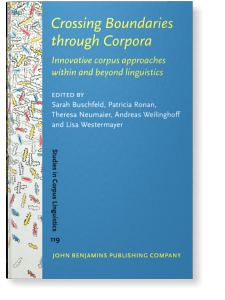Crossing Boundaries through Corpora
Innovative corpus approaches within and beyond linguistics
e-Book – Ordering information
ISBN 9789027246486 | EUR 120.00
| USD 156.00
This volume illustrates new trends in corpus linguistics and shows how corpus approaches can be used to investigate new datasets and emerging areas in linguistics and related fields. It addresses innovative research questions, for example how prosodic analyses can increase the accuracy of syntactic segmentation, how tolerant English language teachers are about language variation, or how natural language can be translated into corpus query language. The thematic scope encompasses four types of ‘boundary crossings’. These include the incorporation of innovative scientific methods, specifically new statistical techniques, acoustic analysis and stylistic investigations. Additionally, temporal boundaries are crossed through the use of new methods and corpora to study diachronic data. New methodologies are also explored through the analysis of prosody, variety-specific approaches, and teacher attitudes. Finally, corpus users can cross boundaries by employing a more user-friendly corpus query language.
[Studies in Corpus Linguistics, 119] Expected October 2024. vi, 260 pp.+ index
Publishing status:
© John Benjamins
Table of Contents
-
Chapter 1. Introduction: Crossing discipline boundaries with corpus‑linguistic methodsPatricia Ronan, Sarah Buschfeld, Theresa Neumaier, Andreas Weilinghoff and Lisa Westermayer | pp. 1–6
-
Crossing boundaries: Integrated approaches
-
Chapter 2. New approaches to investigating change in derivational productivity: Gender and internal factors in the development of ‑ity and ‑ness, 1600–1800Tanja Säily, Martin Hilpert and Jukka Suomela | pp. 8–40
-
Chapter 3. A corpus-based comparative acoustic analysis of target-like vowel production by L1-Japanese learners and native speakers of EnglishMartin Schweinberger and Yuki Komiya | pp. 41–61
-
Chapter 4. Digital Dickens: An automated content analysis of Charles Dickens’ novelsGerold Schneider | pp. 62–98
-
Crossing boundaries: Change over time
-
Chapter 5. 120 years of reporting clauses: Stability or change?Jarle Ebeling | pp. 100–124
-
Chapter 6. Establishing a ‘new normal’: Detecting fluctuating trends in word frequency over timeMatt Gee, Andrew Kehoe and Antoinette Renouf | pp. 125–152
-
Crossing boundaries: New approaches
-
Chapter 7. Syntactic segmentation of spoken corpus data: What prosody can contributeKarin McClellan, Kathrin Kircili and Sandra Götz | pp. 154–191
-
Chapter 8. Short-term diachronic and variety-internal approaches to textual functionality in South Asian Englishes: Evidence from newspaper languageTobias Bernaisch and Sven Leuckert | pp. 192–216
-
Chapter 9. Do corpus data on World Englishes inspire tolerance of variation in ELT professionals? An experimental questionnaire study with native English speaking teachersJulia Schlüter | pp. 217–245
-
Crossing boundaries: Accessibility
-
Chapter 10. Query a corpus in near-natural language: A human-friendly corpus query language not only for linguistsJiří Milička and Denisa Šebestová | pp. 248–262
Subjects
Main BIC Subject
CFX: Computational linguistics
Main BISAC Subject
LAN009000: LANGUAGE ARTS & DISCIPLINES / Linguistics / General
